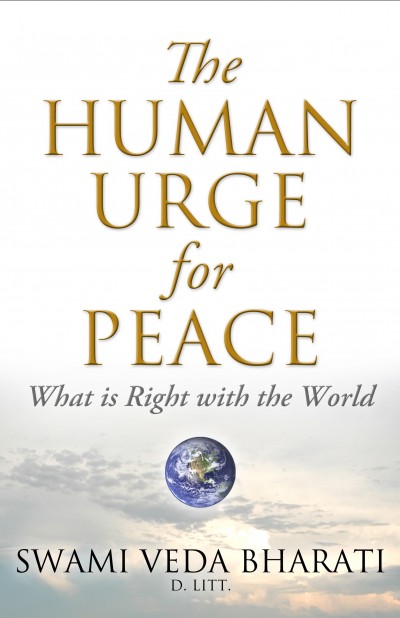Book Club/Study Group via Zoom
Facilitated by Swami Radha Bharati, Jim Nelson, and Michael Smith
10:00 a.m. – 11:30 a.m.
“The Human Urge for Peace, What is Right with the World”
by Swami Veda Bharati
To receive the zoom link for this event, please subscribe to The Meditation Center’s e-newsletter on the home page of this website.
There will be one zoom link for both Sunday morning meditation and the Book Club. You can join and leave the meeting according to your schedule and needs.
Sunday Morning Meditation with Swami Radha Bharati
8:30 a.m. – 9:15 a.m.
Book Club/Study Group
Facilitated by Swami Radha Bharati, Jim Nelson, and Michael Smith
10:00 a.m. – 11:30 a.m.
THE HUMAN URGE FOR PEACE:
WHAT’S RIGHT WITH THE WORLD
by Swami Veda Bharati
“It is my hope that after reading this book, you will have a greater understanding, not only of what is right with the world but how the beauty of that which is right can be applied to beautify what has become “ugly” in so many eyes. May the reader enjoy what is beautiful in the world.” (Swami Veda Bharati)
“This needs to be our handbook for these times of discord and conflict on so many levels.” (Swami Ritavan Bharati)
We will begin with Chapter One: “Perennial in the Millenium. Read here.
This book can be obtained through Lotus Press: Click here to order.
__________________________________
The Human Urge for Peace:
What’s Right with the World
by
Swami Veda Bharati
Drawing on myriad examples gathered from his lifelong travels around the globe, Swami Veda – a teacher of yoga and meditation and tireless peace advocate – offers a visionary plan to create and sustain lasting peace in the world.
He invites his readers on a spiritual journey, to free their minds from internal conflict using contemplative methods common to all religions and then to join in bringing education for peace into the family, schools and colleges, the workplace, and ultimately a global confederation of cultures, nations and religions.
_________________________________
The Human Urge for Peace: What is Right with the World takes readers on a marvelous journey through time and space to observe how people of many different cultures and religions manage to live peaceably and equably together.
Examples are provided where communities with two religious or ethnic groups, even in war-torn countries like India and Pakistan, respect or even share holy sites and celebrations. Swami Veda identifies the common threads shared by all religions past and present, especially the contemplative traditions of silence and meditation whereby the mind is trained to become calm and free of conflict, and he suggests ways that religious leaders and educators can train parents and students alike to maintain calm, peaceful, harmonious and conflict-free minds.
Swami Veda invites readers to “Give way to our natural human urges –the urge to give, the urge to share, the urge to make sacrifice for others, the urge to knowledge, the natural urge to peace. ” This is “ what is right with the world.”
Enough has been said about what is wrong. It is true that much work needs to be done before the conflicts that lead to violence and war cease to arise, in individuals, ethnic groups, religions or nations, but the path toward peace is one of looking for positive examples, both past and present, and emulating them.
In the final chapter Swami Veda outlines his proposal for a World Council of Ethics and Peace and gives his recommendations for instituting planet-wide educatio for ethical conduct and peace.
_________________________________
Swami Veda asks religious leaders to honor their commonalities with other religions and separate themselves from “divisive concepts binding ethnicity and religion”which may be used to create dissension and increase hatred.
Swami Veda invites readers to “Give way to our natural human urges – the urge to give, the urge to share, the urge to make sacrifice for others, the urge to knowledge, the natural urge to peace.” This is “what is right with the world.”
Enough has been said about what is wrong. It is true that much work needs to be done before the conflicts that lead to violence and war cease to arise in individuals, ethnic groups, religions, or nations; but the path toward peace is one of looking for positive examples, both past and present, and emulating them.
In the final chapter Swami Veda outlines his proposal for a World Council of Ethics and Peace and gives his recommendations for instituting planet-wide education for ethical conduct and peace.
Swami Veda asks religious leaders to honor their commonalities with other religions and to separate themselves from divisive concepts that bind and religious extremism which can be used to create dissension.
Teachers and students of Peace Studies will find much of special value to them in Swami Veda’s book.
__________________________________
Swami Veda Bharati (1933-2015) was born into a Sanskrit-speaking family in India and began his education in the ancient texts of yoga philosophy at the age of five. He received a doctoral degree in Holland and taught Sanskrit at the University of Minnesota. For over 60 years Swami Veda traveled to every continent, where he established yoga and meditation centers, lectured at universities, and worked with peace foundations including the World Parliament of Religions and the UNESCO Centre for Peace Studies. He also wrote many books about yoga and meditation, including a translation of the Yoga Sutras of Patanjali and several volumes of stories and poems. His residence for the last 20 years of his life was at Swami Rama Sadhaka Gram (SRSG) at the foothills of the Himalayas in Rishikesh, India, where he guided thousands of students of all ages on the paths of inner peace and social harmony.





